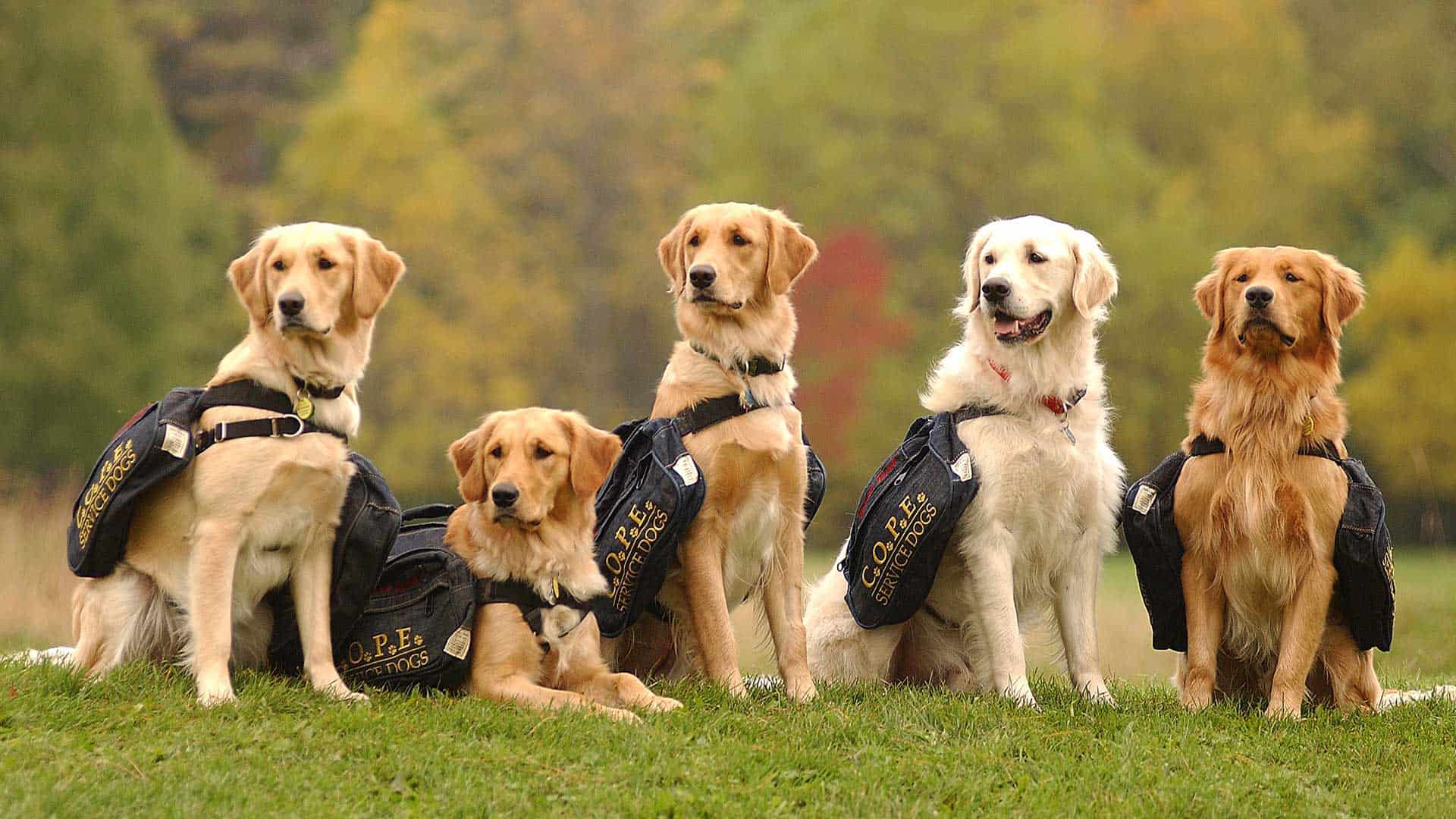Service dogs are a boon for the physically and mentally challenged people. However, in order for them to master this skill, training a service dog is required.
A service dog has to be capable of undertaking disability-specific tasks for their handler/owner.
Additionally, a handler/trainer has to be accustomed to acceptable training methods and be well aware of the care and health of dogs.
Moreover, the handler/trainer must realize the value of their dog’s proper behavior in public.
With the right service dog training, the dogs have the potential to become your best friends. They will certainly look after you, but they will also rely on you to supply the necessary shelter and food.
As a handler/owner, you can develop a strong and long-lasting bond with your service dog and bring betterment to both of your lives.
Table of Contents
Basic Guidelines about Service Dogs

As per the law, service dogs are defined as trained working dogs that perform duties for people with mental or physical disabilities.
It is very important that the dog is able to perform particular tasks that are directly related to the disability of the concerned individual.
These specific tasks can involve opening doors for wheelchair-bound individuals and alerting the owner of his imminent seizure.
Service dogs are not to be thought of as pets and they must be made less sensitive to interruptions. Their prime focus should be only on their owner and they must be able to ignore distractions like children, traffic, etc.
Even though service dog training is necessary, it doesn’t mean that training a service dog on your own is impossible. Many individuals opt to self-train their dogs because professional help is often lengthy and expensive in training service dogs.
Even with the help of professional trainers, sufficient success is not always achieved.
The duration for training a service dog can take up to two years while a special service dog training vest is given to be worn by the dogs for their easy identification.
For a dog to become a service dog, there is no restriction on its age or breed. Yet, they need to possess some characteristics, without which, they might not do best as service dogs.
Service dogs need to possess the following abilities:
- Willingness to please
- Ready to go behind their owners wherever they go
- Friendly and calm
- Quick to acquire knowledge
- Able to hold on to information
- Socialized
- Alert
- Unaffected by strangers and the general public
Types of Service Dogs
Hearing dogs
These dogs help people who have hearing impairment. They carry out the following tasks:
- Warn about sounds or presence of people around
- Carry messages
- Recover dropped objects
- Warn people about approaching vehicles
Guide Dogs
These dogs are trained to help people who have visual impairment and bring about freedom and security to their owners. They carry out the following tasks:
- Recover and carry objects
- Indicate changes in elevation levels
- Assist in obstacle and moving vehicle avoidance
- Locate people and objects on command
Service Dogs
Training a service dog varies according to the needs and the disability of the owner, such as training for mobility assistance and training for medical assistance.
Medical assistance comprises of psychiatric assistance and autism assistance.
The well-trained service dogs can achieve great heights in assisting their owners.
Below is a list of the duties and services a well-trained dog can execute:
- Recognize and warn of symptoms
- Prevent falls and ensure stability
- Assist people in getting dressed and undressed
- Help people to get into an upright position
- Evaluate the owner’s safety and lead him away from stressful situations
- Break psychological flashbacks and prevent self-hurting behaviors by utilizing tactile stimulation
- Provide deep pressure stimulation
- Place feet and arms onto the armrests and footrests of a wheelchair
- Switch lights on or off
- Open and shut cabinets, drawers, and doors
- Bark on command or find help on command
- Assist with insomnia and break nightmares
- Find vehicles, places, or their owner when disoriented and restore safety.
- Recognize high and low blood sugar levels and detect allergens
- Call 911 during an emergency
Evidently, some of these tasks are highly complicated such as calling 911 during an emergency and alerting owners to certain symptoms.
Hence, service dogs call for comprehensive and complex training. Still, it can’t be guaranteed that the dog will be in a position to become a full-time service dog.
Suggested: Top 10 Police Dog Breeds | K9 Intelligent Dogs
General Service Dog Training
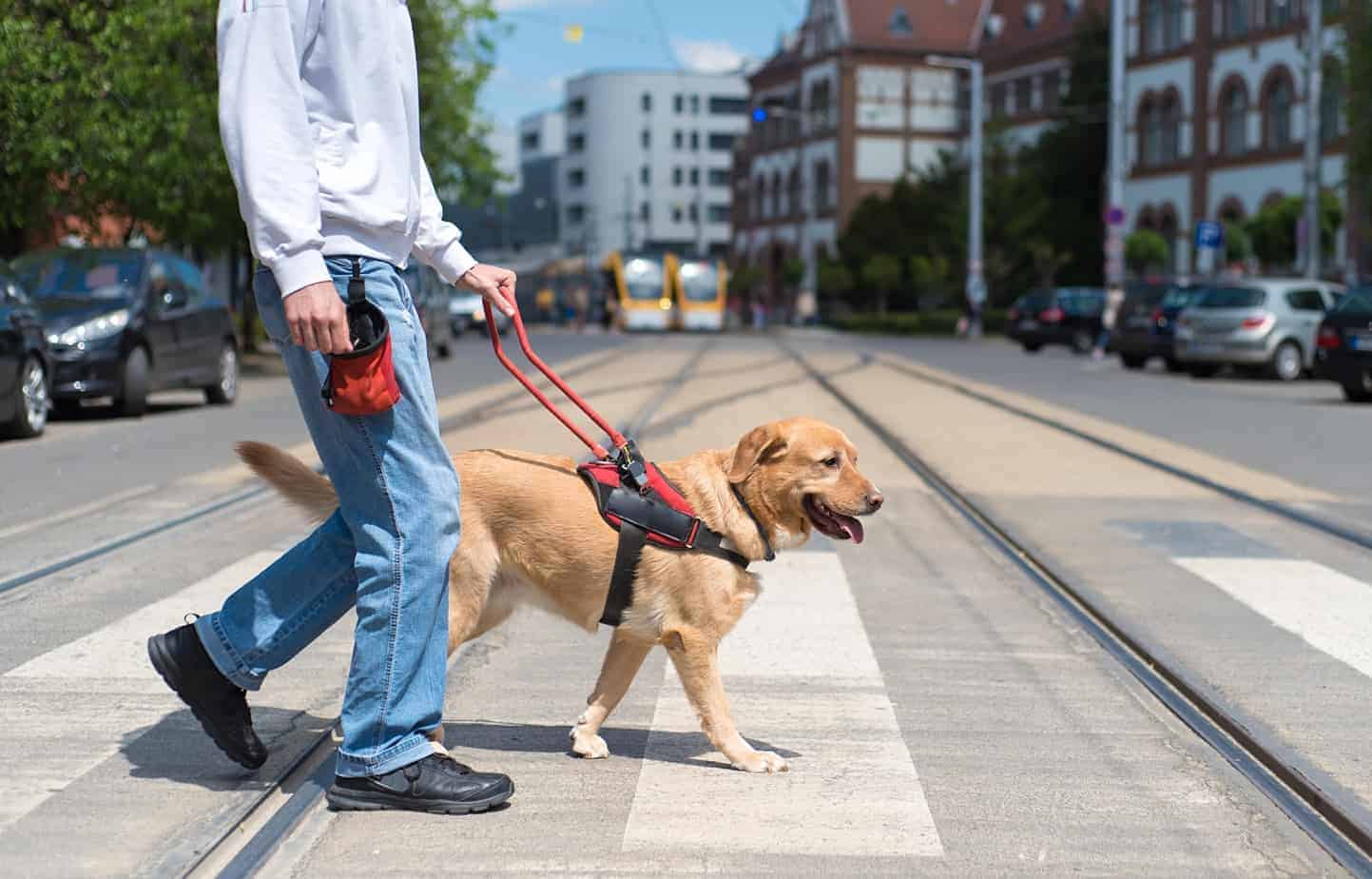
The global standards for training a service dog stipulate that at least 120 hours of training a dog is required for over six months.
Also, the standard specifies that at least 30 hours should comprise of public access skills. In some cases, the training has been observed to last up to 2 years depending on the dog.
Every dog will require some degree of ongoing maintenance training.
Learning complicated tasks can be quite time-consuming for the dog.
Tips on Self-Training a Dog
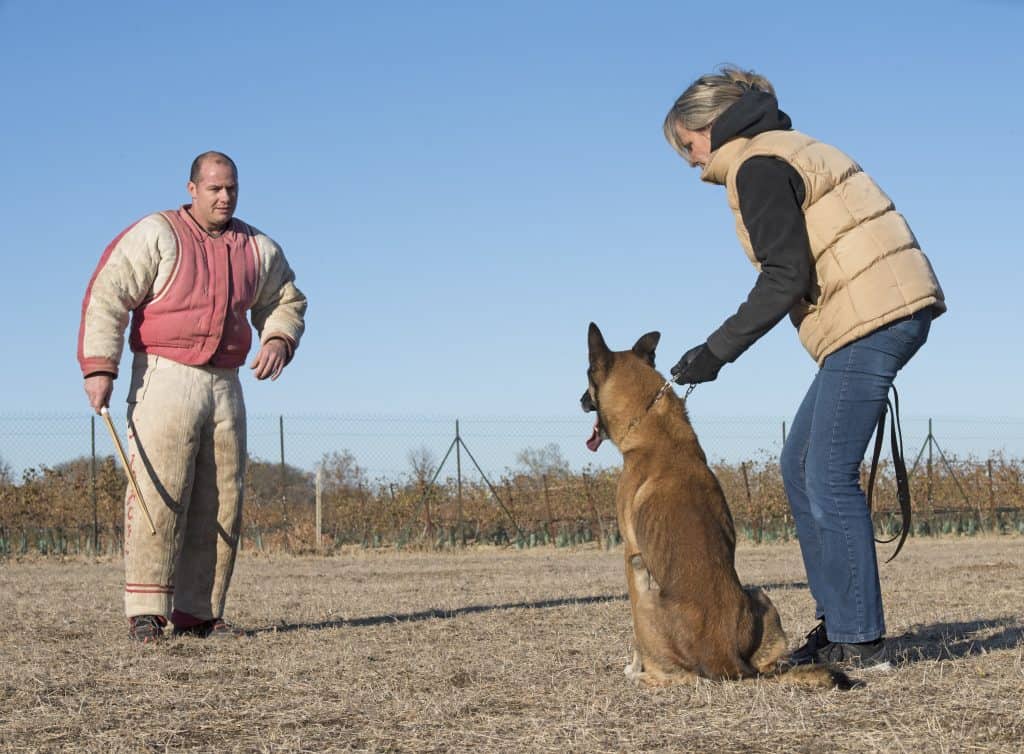
If you choose for training a service dog on your own, a training guide for service dog training would be useful.
Firstly, you must verify whether your dog is fit for being a service dog. Secondly, it’s crucial that a sequence for training is established.
We advise to teach the dog tasks and commands that are less complex. The basic service dog commands are “stay”, “sit”, “come”, “heel”, and “lie down”. We also highly recommend these 10 basic dog training commands.
Then, you are supposed to evaluate the dog’s obedience in various environments and make sure that commands are followed regardless of your location or the situation around you.
In the end, you can commence teaching him particular tasks that he will perform.
As one can expect, a lot of patience is required from the time you start training your dog until the last step. If you come across any hurdle in the process, consult a professional for help.
Training a Service Dog for Disability-Related Tasks
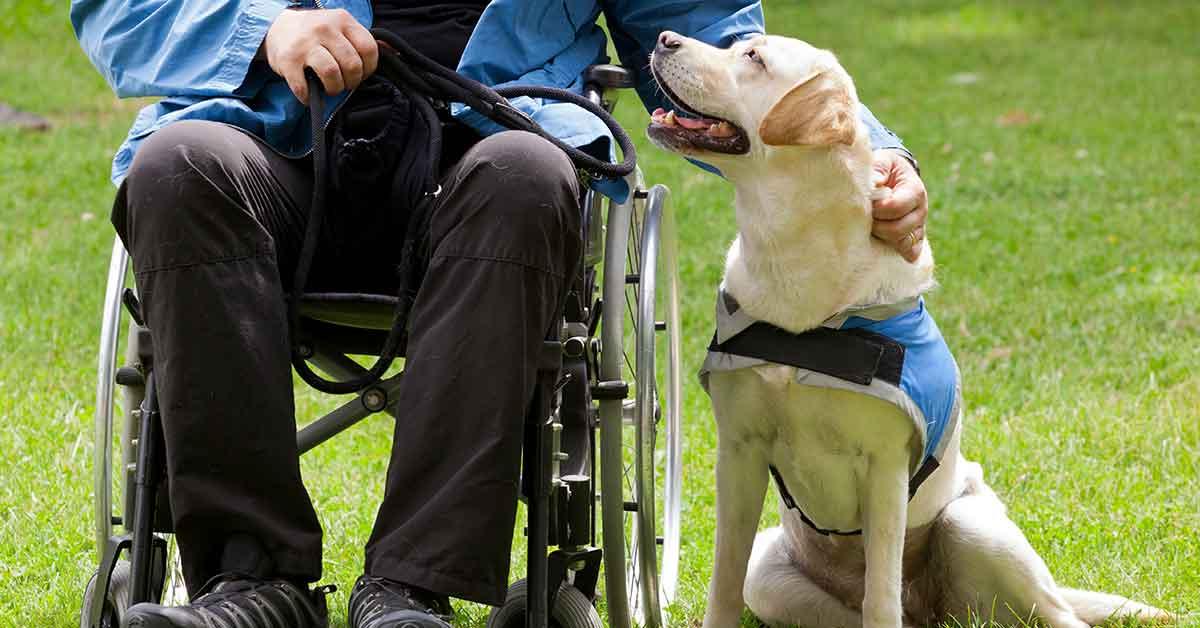
Some of the traits that define a potential service dog are intelligence, eagerness to please, and well-behaved. Not every service dog can put a focus on their handlers at all times or perform disability-specific tasks.
Additionally, these dogs have to execute certain tasks on command. For a dog to pass the test, he must answer to the first command of the handler 90% of the time, irrespective of the environment.
One of the tasks done on commands is fecal elimination. Yes, the dog must be able to timely answer the potty commands of the handler.
You also need to train your dog for conducting proper behavior in public and in different settings.
A part of training, also called desensitization, means teaching your dog to disregard all distractions and solely focus on the tasks and the handler.
Service dogs can be advantageous in disability conditions such as mental or physical, and the apparent as well as those that aren’t apparent.
Given below are the common disability-related tasks that the service dogs execute for their handlers:
- Recovering items
- Warning of diabetes and seizure attacks
- Reminding people to take medications
- Pulling a wheelchair
- Soothing persons with traumatic attacks during PTSD
- Warning the deaf to noises
- Guiding the blind
It is worth remembering that if you possess a service dog, all public areas are accessible in its company.
Moreover, people cannot inquire about the details of the owner’s/handler’s disability.
People are restricted to questions such as whether your dog is a service dog and about the tasks he can perform for you.
The handler/owner doesn’t require to show what the dog does for him or he needn’t answer any other questions.
The types of training for the service dogs include training an autism service dog, training a service dog for PTSD, training a service dog for anxiety, training a psychiatric service dog, etc.
vice dog, training a service dog for PTSD, training a service dog for anxiety, training a psychiatric service dog, etc.
How to Train a Service Dog for Anxiety?

Service dogs can be specifically helpful in treating mental conditions such as PTSD and anxiety. Follow the following steps for training a service dog for anxiety:
1.Choose the Right Service Dog:
These qualities are essential in a dog while choosing the service dog for tackling mental difficulties:
- Follows
- Alert
- Eager to be held
- Social and quick to greet
- Not easily able to get startled
2. Determine the Service Dog’s Duty:
First, determine what you want your puppy to do for you. After this, you can start bonding with your dog. This makes a starting point for your dog to identify when you are in a relaxed state and when you start to feel anxiety.
3. Develop Socialization Skills
This is very necessary as you don’t want your dog to get scared or stressed when it encounters new experiences.
4. Begin Basic Training
Teach your dog to follow basic commands. If required, seek the help of a professional trainer.
5. Sharpen your Dog’s Public Access Skills
After your dog has mastered following basic commands, start making him used to the hustle and bustle of public places.
6. Individual Response Training
Hugging your dog closely when you are in anxiety is very beneficial in bringing reassurance to you and will also enable the dog to pick up your symptomatic signs for later use.
Selecting and Formally Training a Service Dog
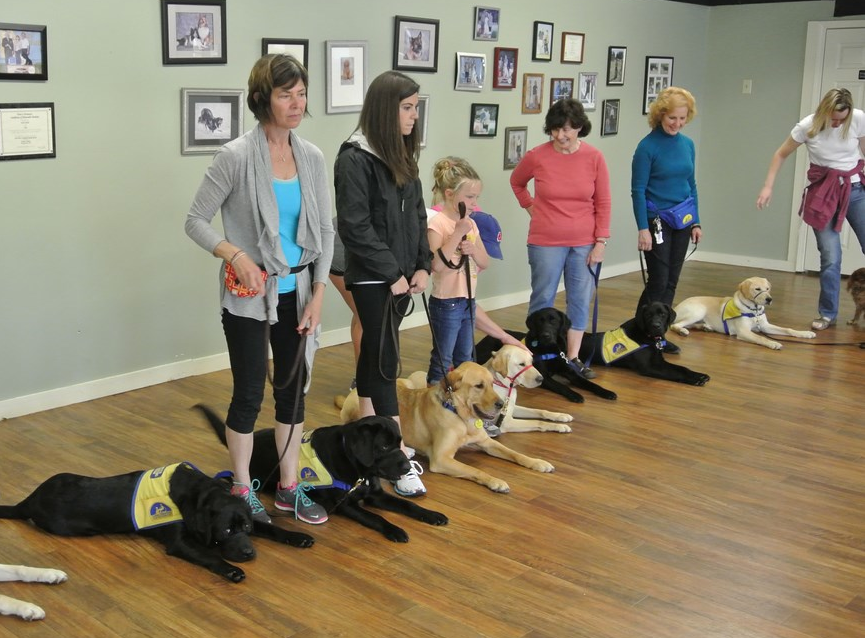
Most service dogs are bred solely for the purpose of doing service work, while some are taken from shelters/rescues, private breeders or pet dogs before their formal training.
For the dogs to work safely and productively, a unique temperament is demanded of them. Therefore, selecting the right training dog becomes imperative.
Usually, the formal training for a service dog takes four to six months. This depends on several factors such as the tasks to be executed, the degree of owner/handler involvement, the type of service dog, and his training history.
Cost of Training a Service Dog

In totality, the service dog training cost can be around $7000. This expense includes training to execute basic tasks. More thorough training can cost up to $20,000.
You can safely assume that the average cost of a service dog having public access is roughly $10,000. The cost increases as more specific tasks are demanded.
Some Facts About Training a Service Dog

As an owner/handler, you also have to pay fees for the exercise of dogs. The people with disabilities will have physical limitations and so would employ a dog walker or would purchase a treadmill.
With these great requirements demanded of them, a regular poodle service dog can work for nearly 8 years of its lifetime, with the initial phase being the training phase and the later phase being the retirement phase.
In many instances, experienced service dogs can assist other novice service dogs in training.
Let us know the updates in service dog world by commenting below.
Stay around for more enlightening reads in the world of dogs.
Happy Petting to You Guys!



